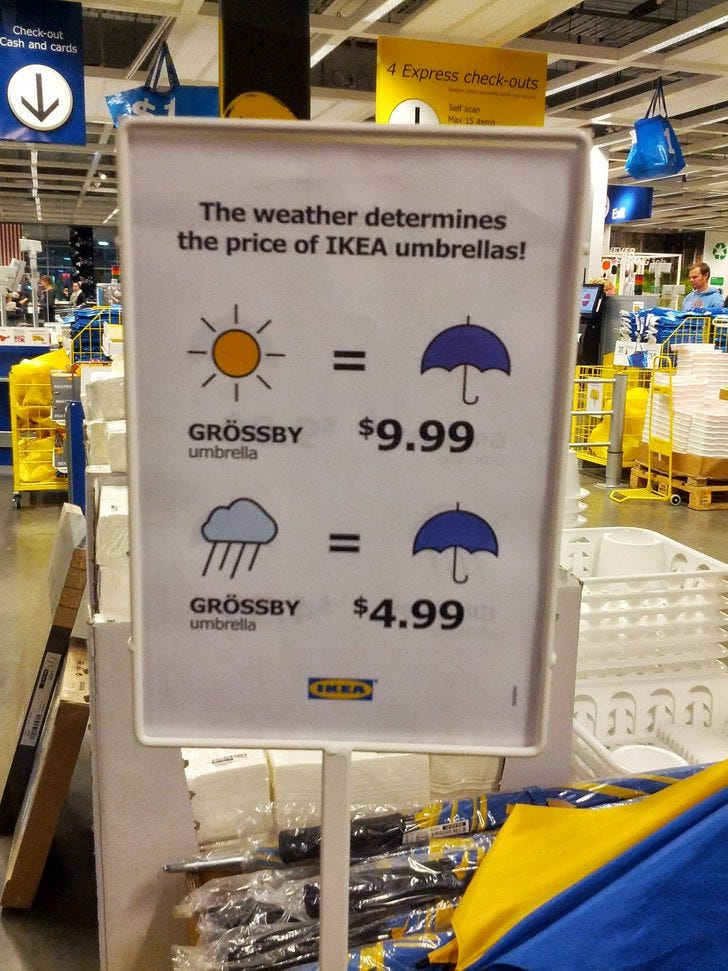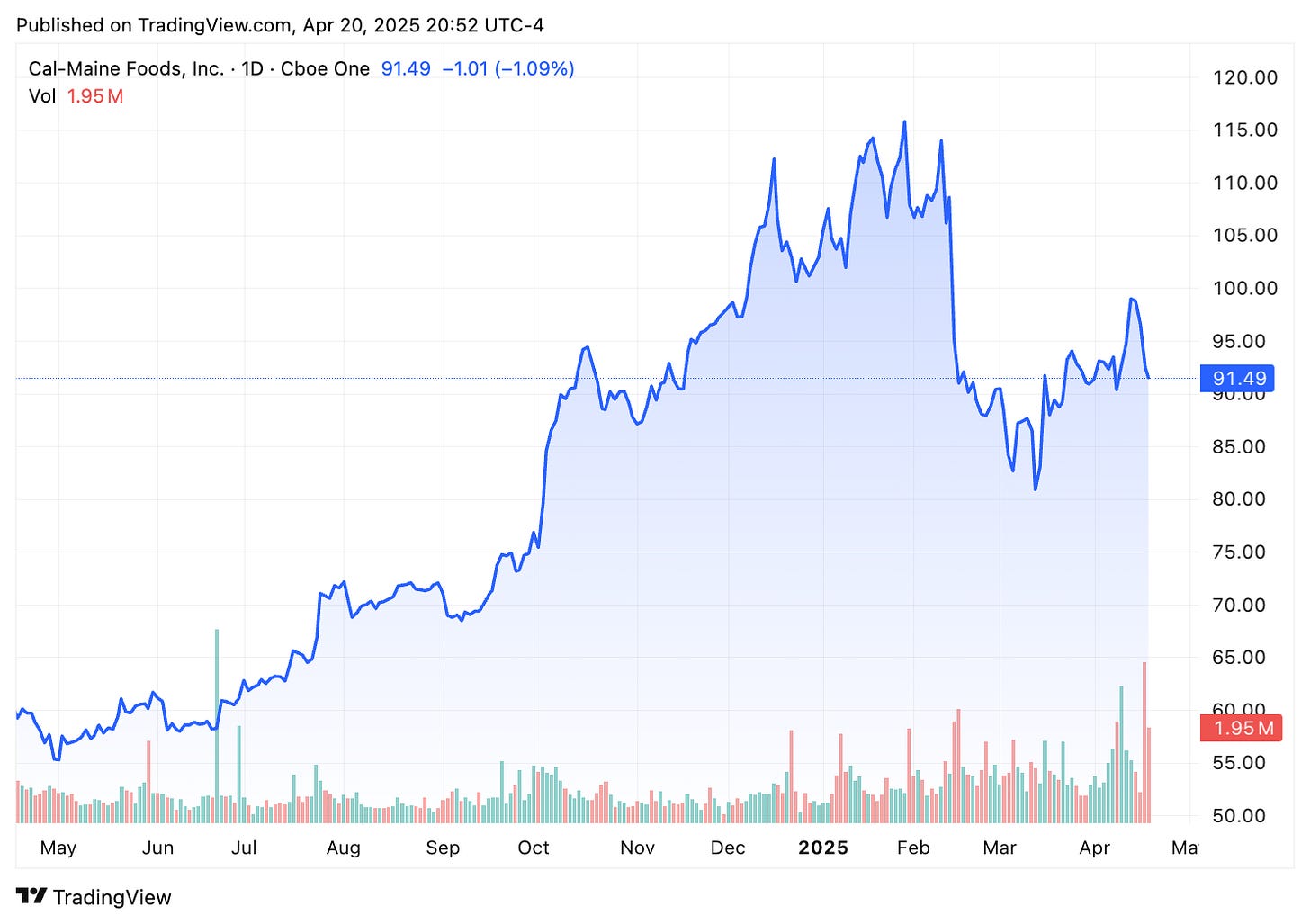Not All Price Hikes Are Created Equal
Egg prices are still high, even though bird flu cases are down and production costs are falling. So why aren’t prices falling, too? And why does it all feel a little unfair?
You’re reading Monday Morning Economist, a free weekly newsletter that explores the economics behind pop culture and current events. Each issue reaches thousands of readers who want to understand the world a little differently. If you enjoy this post, you can support the newsletter by sharing it or by becoming a paid subscriber to help it grow:
It’s been a strange few weeks for egg prices. Leading up to Easter weekend, headlines warned that the holiday tradition of dyeing eggs might be too pricey for some families to justify. Meanwhile, the President suggested that egg prices might actually be too low.
So... which is it?
The most recent numbers from the Bureau of Labor Statistics show that retail egg prices hit a record high last month, but that includes organic and cage-free eggs as well. The most recent USDA report has the wholesale prices for extra-large white eggs holding steady at around $3 per dozen, with the retail price around $3.93.
That gap between what grocery stores pay and what shoppers pay is confusing customers and turning into a full-blown trust issue.
Why Are Retail Egg Prices So Much Higher?
Wholesale prices are the prices retailers and distributors pay. Retail prices are what you and I pay at the store. They’re not supposed to be the same.
Every step of the supply chain adds a small markup to cover transportation, storage, and profit. That’s normal. But when retail prices are a lot higher than wholesale prices, people start asking questions. That’s especially true when the country’s largest egg producer saw its profit triple last quarter.
Cal-Maine says it’s a supply issue—ongoing bird flu outbreaks have kept production tight. But they also point out that their feed costs dropped nearly 10%, helping their margins. From a business perspective, that story adds up. But from a consumer perspective, it feels off.
When prices go up during a crisis, people expect them to come back down when the crisis eases. But when they don’t? It doesn’t just look like inflation. It feels like something more sinister.
When High Prices Feel Fair vs. When They Don’t
Back in the 1980s, Daniel Kahneman, Jack Knetsch, and Richard Thaler ran a series of experiments to test how people respond to price increases. One scenario asked whether it was acceptable for a hardware store to raise the price of snow shovels the morning after a big snowstorm.
From a textbook perspective, it’s a no-brainer: demand increases, prices go up. But most people said it wasn’t just inconvenient—it was unfair.
This reaction became the basis of what they called dual entitlement. The idea is simple: consumers believe that businesses deserve a reasonable profit, but they also believe they deserve a reasonable price. And when those two expectations conflict, people don’t care about supply and demand charts.

If a business raises prices because its costs go up—say, fuel, feed, or labor—consumers might grumble, but they generally accept it. But if prices go up simply because the business can charge more, especially during a crisis, that feels like exploitation.
Which brings us back to eggs.
During the height of the bird flu outbreak, when millions of hens were being culled, shoppers likely understood that prices would increase. It was painful, but it made sense. It was a cost-based change. But now that outbreaks have slowed and production is much more stable, many people expect prices to fall just as fast.
And when they haven’t? That shift—from cost-driven to profit-driven—is what makes people feel like greed has taken over.
Commodities, Competition, and Cal-Maine
Eggs are a commodity. In theory, commodity prices are shaped by supply and demand, not by any one company. If supply drops—say, from a bird flu outbreak—prices rise. But commodities are also supposed to be competitive. If one producer raises their prices too much, another producer can undercut them. That’s how markets keep businesses honest. Unless one business is too big to be undercut.
Cal-Maine produces about 1 in every 5 eggs in the U.S. That kind of market share leads to a lot of influence. Most egg farmers are price takers: they respond to market prices. Cal-Maine, on the other hand, is big enough to help set them.
That doesn’t automatically mean it’s doing anything illegal. But it does mean people pay closer attention, especially because Cal-Maine has a history.
A few years ago, the company was found liable for price fixing in a civil case, accused of intentionally restricting supply to drive up prices. That’s different from the current claims of price gouging, which is when prices are increased sharply during a crisis.
But when prices stay high, and the biggest player is reporting record profits, it’s not hard to see why people might suspect more than just market forces.
The Department of Justice seems to agree. In March, it opened a probe into egg pricing. Cal-Maine says it’s cooperating.

Final Thoughts
So, is Cal-Maine just riding the wave or steering the ship? It’s possible the company simply got lucky: higher prices and lower costs at the same time. But it’s also possible that its market power gave it the ability to nudge prices upward in ways smaller producers can’t.
And that’s what makes people uneasy. Not just the high price itself, but the sense that someone, somewhere, might be doing something other than responding to market forces.
Now compare that to Canada. Our neighbors to the north had plenty of eggs to go with their Canadian bacon. One reason? Canada’s egg market is made up of smaller, more localized producers. There’s also no single company with the kind of market dominance that Cal-Maine holds in the U.S.
The changing price of eggs is more than just an economic story, it’s a story about what consumers consider fair. And if we want to understand consumer frustration, we can’t just look at charts. We have to look at what people believe they’re entitled to.
Thank you for reading Monday Morning Economist! This free weekly newsletter explores the economics behind pop culture and current events. This newsletter lands in the inbox of thousands of subscribers every week! You can support this newsletter by sharing this free post or becoming a paid supporter:
In 2023, a federal jury ordered major egg producers to pay nearly $53 million in damages after they were found conspiring to artificially limit egg supply and raise prices [Associated Press]
United States egg production totaled 7.85 billion during February 2025, down 9% from last year [USDA]
Cal-Maine said it sold a record 331.4 million dozen-eggs in the third quarter of last year, a 10% increase from the same period a year ago [CNN Business]
The typical egg farm in Canada has about 25,000 laying hens, whereas many farms in the U.S. have well over a million [NPR]








Nobody's being forced at gunpoint to buy eggs. Definitionally, if someone engages in that transation, they're better off, and it was voluntary; ergo, the transaction was fair. "Unfair" is, as Norm would say, a bunch of commie gobbledygook.
MEDIA: Stop talking about egg prices and tariffs! They are minimally related if at all!!
93 billion eggs are produced in U.S. every year (2023). In 2020 U.S. imported 180 million eggs: about 0.2% of egg production.
The high cost of eggs is primarily due to a severe bird flu outbreak that has significantly reduced the egg-laying hen population. Outbreaks of avian influenza, or bird flu, have led to the culling of millions of birds, including many egg-laying chickens, causing a decrease in egg supply and a subsequent increase in prices. As chicken populations are revived and egg production goes up, egg prices will come down.